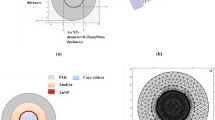Abstract
In this paper, a surface plasmon resonance (SPR) based fiber optic ammonia gas sensor has been designed and fabricated using bromocresol purple (BCP) as sensing element. The sensor works under wavelength modulation scheme. The detection of ammonia gas has been carried out at room temperature. Three different kinds of film coating configurations, namely silver + BCP, gold + BCP, and silver + silicon + BCP on the unclad portion of the fiber have been used for studying the role of each layer. Further, to optimize the performance of the sensor, the films of varying thicknesses were coated using thermal evaporation technique. Experiments have been performed for the ammonia concentrations ranging from 0 to 150 ppm around the probe. To record the SPR spectrum, light from a polychromatic source is launched in the fiber and the spectrum is recorded at the other end of the fiber. The spectrum has a peak at lower wavelength while a dip at the higher wavelength. The dip corresponds to SPR while the peak appears to be due to fluorescence properties of the dye. It has been observed that as the ammonia gas comes in contact of the BCP layer, it changes the refractive index of the BCP dye which, in turn, changes the resonance wavelength. Further, the change in refractive index increases as the concentration of ammonia gas increases up to certain concentration of ammonia after that it saturates. Silicon layer has been shown as a protection layer for silver and gold from oxidation and acts as a tuner of wavelength. The proposed ammonia sensor has small response as well as recovery time.






Similar content being viewed by others
References
Homola J, Yee SS, Gauglitz G (1991) Surface plasmon resonance sensor: review. Sens Actuators B 54:3–15
Sharma AK, Jha R, Gupta BD (2007) Fiber-optic sensors based on surface plasmon resonance: a comprehensive review. IEEE Sens J 7:1118–1129
Abdulhalim I, Zourob M, Lakhtakia A (2008) Surface plasmon resonance sensors: a mini review. Electromagnetics 28:213–242
Kretchmann E (1972) Decay of non radiative surface plasmons into light on rough silver films: comparison of experimental and theoretical results. Opt Commun 6:185–187
Barnes WL, Dereux A, Ebbesen TW (2003) Surface plasmon subwavelength optics. Nature 424:824–830
Raether H (1988) Surface plasmons on smooth and rough surfaces and on gratings. Springer, Heidelberg
Gupta BD, Verma RK (2009) Surface plasmon resonance-based fiber optic sensors: principle, probe designs and some applications. J. Sensors 2009: 979761
Herrera ND, Esteban O, Navarrete MC, Gonzalez-Cano A, Benito-Pena E, Orellana G (2011) Improved performance of SPR sensors by a chemical etching of tapered optical fibers. Opt Laser Eng 49:1065–1068
Verma RK, Gupta BD (2008) Theoretical modelling of a bi-dimensional U-shaped surface plasmon resonance based fibre optic sensor for sensitivity enhancement. J Phys D: Appl Phys 41:095106
Gentleman DJ, Obando LA, Masson JF, Holloway JR, Booksh K (2004) Calibration of fiber optic based surface plasmon resonance sensors in aqueous systems. Anal Chim Acta 515:291–302
Bailescu F, Cosofret VV (1978) Applications of ion-selective membrane electrodes in organic analysis. Ellis Horwood, Chichester
Meyerhoff ME (1980) Polymer membrane electrode-based potentiometric ammonia gas sensor. Anal Chem 52:1532–1534
Fraticelli YM, Meyerhoff ME (1981) Automated determination of ammonia with a potentiometric gas sensor and flowing internal electrolyte. Anal Chem 53:992–997
Marquis BT, Vetelino JF (2001) A semiconducting metal oxide sensor array for the detection of NOx and NH3. Sens Actuators B 77:100–110
Malyshev VV, Pislyakov AV (2003) Dynamic properties and sensitivity of semiconductor metal-oxide thick-film sensors to various gases in air gaseous medium. Sens Actuators B 96:413–434
Prasad AK, Gouma PI, Kubinski DJ, Visser JH, Soltis RE, Schmitz PJ (2003) Reactively sputtered MoO3 films for ammonia sensing. Thin Solid Films 436:46–51
Chen K, Xu Y, Zhang H, Nie L, Yao S (1997) Novel surface acoustic wave-inter digitated array electrode gas sensor for dissolved ammonia. Fresenius J Anal Chem 357:379–383
Varghese OK, Gong D, Dreschel WR, Ong KG, Keat G, Grimes C (2003) Ammonia detection using nanoporous alumina resistive and surface acoustic wave sensors. Sens Actuators B 94:27–35
Zaatar Y, Zaouk D, Bechara J, Khoury A, Llinaress C, Charles JP (2000) Fabrication and characterization of an evanescent wave fiber optic sensor for air pollution control. Mater Sci Eng B: Solid State Mater Adv Technol 74:296–298
Scorsone KE, Christie S, Persaud KC, Simon P, Kvasnik F (2003) Fibre optic evanescent sensing of gaseous ammonia with two forms of a new near-infrared dye in comparison to phenol red. Sens Actuators B 90:37–45
Ruddy V (1990) An effective attenuation coefficient for evanescent wave spectroscopy using multimode fiber. Fiber Integrated Opt 9:143–151
Messica A, Greenstein A, Katzir A, Schiessl U, Tacke M (1994) Fiber optic evanescent wave sensor for gas detection. Opt Lett 19:1167–1169
Van Gent J, Lambeck PV, Bakker RJ, Popma TJA, Sudholter EJR, Reinhoudt DN (1991) Design and realization of a surface plasmon resonance based chemo-optical sensor. Sens Actuators A 25–27:449–452
Homola J (1993) Model of a chemo-optical sensor based on plasmon excitation in thin silver films. Sens Actuators B 11:481–485
Bhatia P, Gupta BD (2012) Fabrication and characterization of a surface plasmon resonance based fiber optic urea sensor for biomedical applications. Sens Actuators B 161:434–438
Acknowledgments
The present work is partially supported by the Council of Scientific and Industrial Research (India). Priya Bhatia is thankful to the Council of Scientific and Industrial Research, India for providing research fellowship.
Author information
Authors and Affiliations
Corresponding author
Rights and permissions
About this article
Cite this article
Bhatia, P., Gupta, B.D. Surface Plasmon Resonance Based Fiber Optic Ammonia Sensor Utilizing Bromocresol Purple. Plasmonics 8, 779–784 (2013). https://doi.org/10.1007/s11468-012-9472-z
Received:
Accepted:
Published:
Issue Date:
DOI: https://doi.org/10.1007/s11468-012-9472-z




